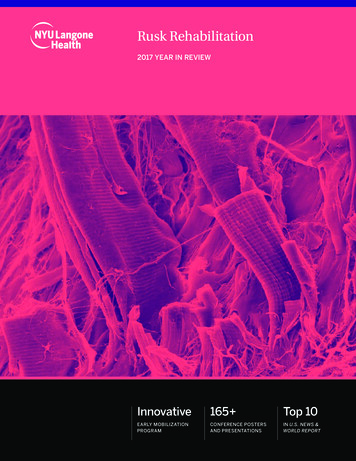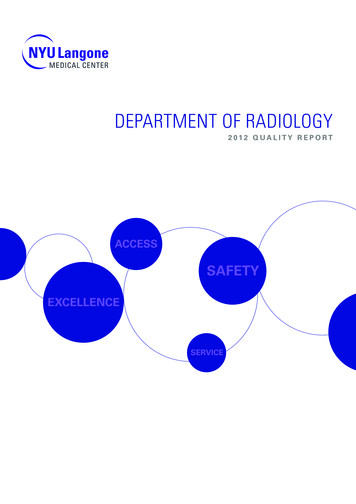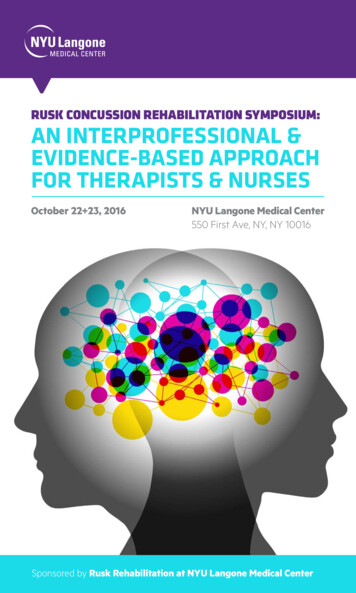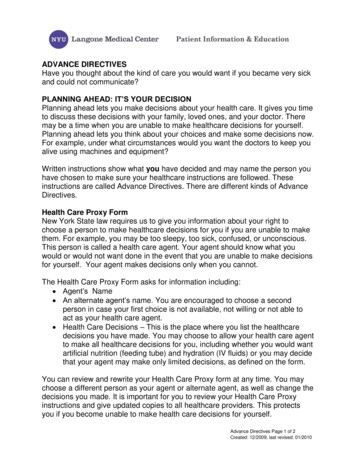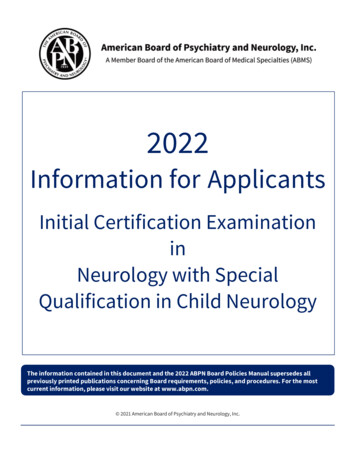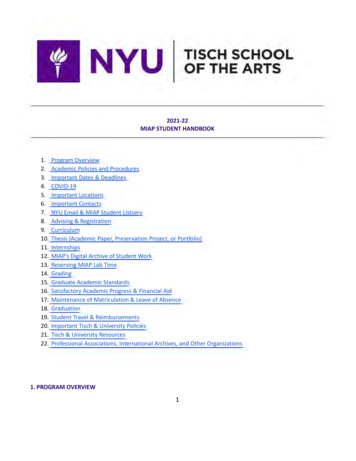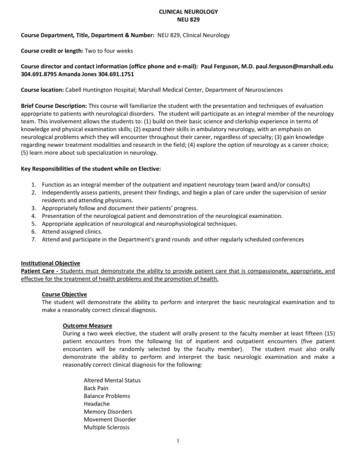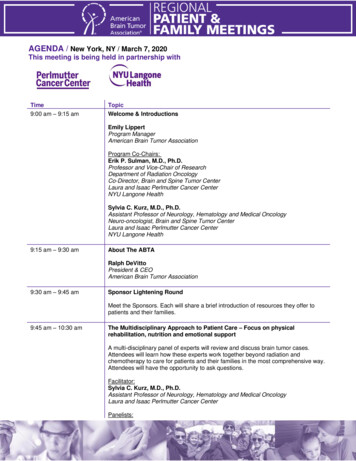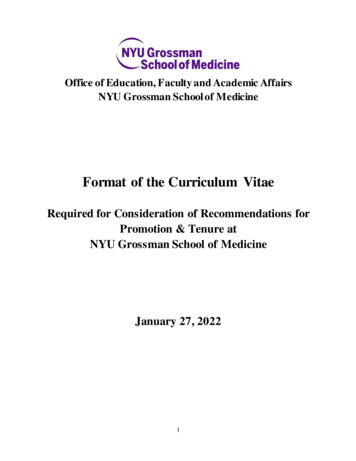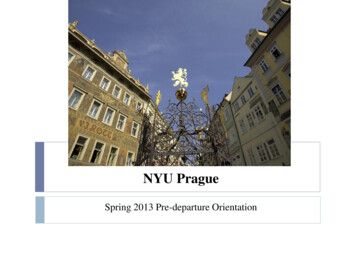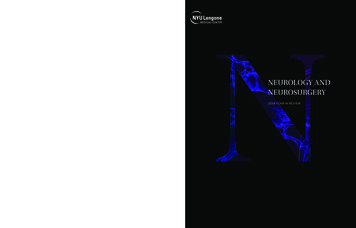
Transcription
NYU Langone Medical Center550 First Avenue, New York, NY 10016nyulmc.orgNEUROLOGY ANDNEUROSURGERY2014 YEAR IN REVIEW
CONTENTS1 Message from the Chairs2 Facts & Figures4 New & Noteworthy8 Clinical Care9 Cerebrovascular Surgery12 Stroke Center24 Multiple Sclerosis Center13 Neuro ICU26 Parkinson’s and MovementDisorders Center14 Brain Tumor Center28 Neuromodulation16 Center for AdvancedRadiosurgery30 Center for Cognitive Neurology32 Pediatrics18 Concussion Center34 Neurogenetics19 Neuro-Ophthalmology36 Neuromuscular20 Comprehensive Epilepsy Center37 Dysautonomia Center23 Neurophysiology38 Spine and Peripheral Nerve23 Neuropsychologyand Neuropsychiatry39 General Neurology40 Research42 Education & Training46 Publications51 LeadershipDesign: Ideas On Purpose, www.ideasonpurpose.comProduced by: Office of Communications and Marketing, NYU Langone Medical Center
NYU LANGONE MEDICAL CENTER / NEUROLOGY AND NEUROSURGERY / 2014PAGE 1MESSAGE FROM THE CHAIRSDear Colleagues and Friends,We are pleased to present this inaugural annualreport from the Departments of Neurology andNeurosurgery at NYU Langone Medical Center.This publication marks a time of significant growth for our departments:Patient volume has risen steadily, we have added stellar faculty members in keystrategic areas, and our research and educational programs continue to expand.Today, all of our subspecialties are staffed by physician leaders, includingmany nationally and internationally recognized clinicians and researchers.Our divisions include one of the largest, most sophisticated epilepsy centers inthe nation; the leading brain, skull-base, and cerebrovascular surgery programsin the New York area; nationally known centers for the treatment of multiplesclerosis and Parkinson’s disease; one of the three most active radiosurgerypractices in the nation; the only U.S. treatment site for familial dysautonomia;a world-class center for clinical care and research into Alzheimer’s disease (AD)and related disorders; a pioneering program for deep brain stimulation; and oneof the country’s largest neuro-ophthalmology groups.This only begins to tell the story of our outstanding clinical, research, andeducational programs. We are proud to work with some of the finest physiciansand surgeons, nursing teams, technicians, and support staff in medicine. Ourcollaborative spirit and collective expertise allow us to treat the most challengingneurologic conditions of every type—from complex brain or spinal tumors torare neurogenetic conditions—and to do so in a consistently caring andcompassionate way.This collaboration is found across our cutting-edge clinical, translational, andbasic science research programs and between our two departments. Whether a caseinvolves our neurologists and neurointerventionalists removing a blood clot froma stroke patient’s brain, our neurosurgeons performing complex procedures underthe monitoring of our clinical Neurophysiology Division, or our seizure and motordisorder specialists working with our epilepsy surgeons and neuromodulationteams on cutting-edge treatments, the close professional bonds between theNeurology and Neurosurgery Departments have enriched both immeasurably.This excellence is also the result of the support we receive from NYU Langoneas a whole, starting with the commitment and vision of our Dean and CEO,Robert I. Grossman, MD. From funding state-of-the-art facilities and technology,to facilitating grant and patent applications and information technologyinfrastructure, this support makes possible everything we do. The same is trueof our collaboration with the Medical Center’s other departments—including theotolaryngologists our surgeons partner with to remove acoustic neuromas; thevascular specialists who work with our Center for Cognitive Neurology to evaluatecognitive disorders; the psychologists who support our AD, multiple sclerosis,and Parkinson’s patients; and the clinicians of Rusk Rehabilitation who help ourpatients recover their functional abilities.Ultimately, we are driven toward excellence for our patients: their strength,perseverance, and willingness to entrust their care to us are what drive us tostrive continually to be the best.STEVEN L. GALETTA, MDPhilip K. Moskowitz, MD Professor andChair of NeurologyDepartment of NeurologyProfessor of Ophthalmology and NeurologyNYU Langone Medical CenterJOHN G. GOLFINOS, MDChair, Department of NeurosurgeryAssociate Professor of Neurosurgeryand OtolaryngologyNYU Langone Medical Center
NYU LANGONE MEDICAL CENTER / NEUROLOGY AND NEUROSURGERY / 2014PAGE 2FACTS & FIGURES*Neurology and NeurosurgeryPATIENT VOLUME4,992neurosurgicalproceduresperformed—a 20% increase from theprior year47,100neurologypatient visits—a nearly 50% increase involume compared to theprior year1,000 #8concussionpatients—for Neurologyand Neurosurgery—treated since ConcussionCenter was establishedin 2013in U.S. News & World Report’s2014–15 “Best Hospitals”FACULTY75full timeNeurology faculty—including 11 new facultymembers in the past year2421with primary appointmentrecognized as “America’s TopDoctors” by Castle Connollyfull timeNeurosurgery faculty—40 neurosurgeons andneurologists—Neurology andNeurosurgeryresidents—currently in trainingRESEARCH AND FUNDING 4,600,000 in neurosurgerygrant funding—received in fiscal year 2013 and 2014100250 grants—presentations—to NYU Langone neurologists for currentresearch, totaling more than 18m in fundinglandmark50 delivered by neurologists andneurosurgeons in 2014 national andinternational conferences 8,000,000epilepsy study—research studies—in donor gifts—published by Comprehensive Epilepsy Center researchers inthe American Journal of Human Genetics (AJHG) showingthat genetic mutations related to synapse function arelinked to severe childhood epilepsiesof new MS medications andother treatments that MSComprehensive Care Centeris currently participating incommitted to theNeurology Department*Numbers represent FY14 (Sept 2013–Aug 2014) unless otherwise noted
NYU LANGONE MEDICAL CENTER / NEUROLOGY AND NEUROSURGERY / 2014PAGE 3NYU Langone Medical CenterRanked #1 forTwo Years in a Rowin overall patient safety and quality, among leadingacademic medical centers across the nation thatparticipated in the University HealthSystem ConsortiumQuality & Accountability StudyRanked #15 on“Best Hospitals”Honor Rollby U.S. News & World Report and nationally rankedin 13 specialties, including top 10 rankings inOrthopaedics (#4), Rheumatology (#6), Geriatrics (#8),Neurology & Neurosurgery (#8), and Rehabilitation (#9)Ranked One of theTop 20 Medical Schoolsby U.S. News & World ReportMagnet Designation forThird Consecutive Termfor Tisch Hospital and Rusk Rehabilitation, an honorachieved by only 2% of hospitals in the country.NYU Langone’s Hospital for Joint Diseases receivedits first Magnet recognition in 2012.
NYU LANGONE MEDICAL CENTER / NEUROLOGY AND NEUROSURGERY / 2014PAGE 4NEW & NOTEWORTHYTransformation ThroughGrowth, Innovation, and CollaborationConcussion CenterReaches 1,000 Patient MarkOne of the few comprehensive, interdisciplinary centersin the United States devoted to diagnosis and treatmentof concussion, NYU Langone’s Concussion Center hastreated over 1,000 patients since it was established inthe spring of 2013. The center maintains a concussionpatient registry, and is currently investigating the useof the King-Devick Test for eye movement, and otherquickly administered cognitive and balance screensfor sideline concussion diagnosis. The Center’s researchon the King-Devick Test was profiled by the AmericanAcademy of Neurology as one of the highlights of theirannual meeting.New Radiosurgery SuiteAllows for IncreasedGamma Knife VolumeEarly in 2014, the Neurosurgery Department opened itsnew radiosurgery suite, a completely renovated facilityhousing a Leksell Gamma Knife Perfexion . With thenew space, the department also saw an impressive 15percent increase in patient volume, to 459 proceduresfor the year, making NYU Langone’s Gamma Knife practice the third-largest in the United States, and themost active in the New York metropolitan area.Model Home Care Programfor Immobile Parkinson’sDisease PatientsNYU Langone’s Parkinson’s and Movement DisordersCenter (PMDC) has launched a multidisciplinaryParkinson’s disease home care program—the first of itskind. Now, when patients with advanced Parkinson’scan no longer travel to appointments, a physician-ledteam visits them at home to conduct a full evaluationand regular follow-ups. The PMDC has also joined withthe Edmond J. Safra Philanthropic Foundation, theNational Parkinson Foundation, and JewishCommunity Center (JCC) Manhattan to bring thisgroundbreaking New York City-based program to fourother U.S. cities.
NYU LANGONE MEDICAL CENTER / NEUROLOGY AND NEUROSURGERY / 2014PAGE 5FDA Approvals on Drugs forLysosomal Storage DisordersNYU Langone neurologists helped lead clinical trials forCerdelga and Vimizim , two lysosomal storage disorderdrugs that got FDA approval in 2014. Research efforts ledby NYU Langone’s Dysautonomia Center also resultedin FDA approval this year of droxidopa for treatingneurogenic orthostatic hypotension—the first newhypotension medication in two decades, and only thesecond ever developed.Smart PacemakerApproved for EpilepsyFaculty at the Comprehensive Epilepsy Center, nowpart of NYU Langone’s Faculty Group Practice, werepart of clinical trials resulting in recent FDA approvalof responsive neurostimulator (RNS) devices, andperformed the nation’s first post-approval RNSimplantation. The device uses sensors and electricalstimulation to detect and shut down incipient seizuresin the brain before they start.Newly IdentifiedCompounds Could ImpactCognitive DisordersNYU Langone’s Center for Cognitive Neurology (CCN)researchers have identified and patented a compound,2-PMAP, which reduces brain levels of toxic amyloidproteins—potential contributors to Alzheimer’s disease(AD) and other cognitive disorders—by more than 50percent in animal studies. The center also developed away to stimulate the body’s innate immune responseusing the Toll-like receptor 9 protein, an approach foundin animal studies to reduce all key Alzheimer’spathologies. CCN researchers have also developed andpatented active and passive vaccination approaches thattarget both Aß and tau pathology concurrently, whichare highly effective in multiple animal models of AD.Stroke Center Growsto Meet Increased NeedIn 2014, NYU Langone opened its Ronald O. PerelmanCenter for Emergency Services, resulting in a 30percent increase in stroke patients. NYU Langone’sComprehensive Stroke Care Center respondedaccordingly, expanding to include three dedicatedneurologists specializing in stroke treatment to provideadvanced care.The Center also has a full-time attendingneuroradiologist, four neurointerventional radiologists,and access to a newly opened, 10-bed NeurosurgicalIntensive Care Unit. Staffed by neurointensivists,neurology and neurosurgery residents, and Magnetrecognized nursing staff, the Neuro ICU cares for themost severely ill stroke, seizure, and other neurologicalpatients. The unit offers the latest in neurologicalmonitoring, including invasive brain monitoring,transcranial Dopplers, and 24/7 EEG monitoring.Advancing Neurosurgerywith Novel Device DesignHoward A. Riina, MD, professor and vice chair ofthe Department of Neurosurgery and director ofendovascular surgery, designed and recently patented abifurcation flow-diverter—a device that steers blood flowaway from brain aneurysms located in branching vessels.
NYU LANGONE MEDICAL CENTER / NEUROLOGY AND NEUROSURGERY / 2014PAGE 6NEW & NOTEWORTHYDeep Brain Stimulationfor Patients with TouretteSyndrome and ObsessiveCompulsive DisorderNYU Langone neurologists and neurosurgeons havepioneered the use of deep brain stimulation (DBS) asa treatment for Parkinson’s disease and other motordisorders, as well as treatment-resistant depression.They are now extending its therapeutic applications toobsessive-compulsive disorder (OCD) and Tourettesyndrome. Clinical trials for DBS in the treatment ofboth conditions began in 2014, and have yieldedpromising early results.“Flight Simulator”Helps NeurosurgeonsPrepare for SurgeryNYU Langone’s neurosurgeons are using a noveltechnology that serves as a “flight simulator,” allowingthem to rehearse complicated brain surgeries beforemaking an actual incision on a patient. The newsimulator, called the Surgical Rehearsal Platform (SRP),creates an individualized, three-dimensionalwalkthrough for neurosurgeons based on the patient’sCT and MRI scans. Its unique software combines lifeliketissue reaction with accurate modeling of surgical toolsand clamps, enabling surgeons to practice navigatingmultiple-angled models of a patient’s brain andvasculature. Says John G. Golfinos, MD, chair of theDepartment of Neurosurgery and associate professorof neurosurgery and otolaryngology, “The SRP will alsoenhance the training of medical students, residents,and fellows, and help them hone their skills in new andmore meaningful ways.”New ProgramTakes on HeadacheA new headache service under the direction of newfaculty member Mia T. Minen, MD, assistant professor ofneurology, will soon provide advanced treatment for themany causes of headache, using medical therapy andother emerging techniques that have demonstratedefficacy in refractory cases.
NYU LANGONE MEDICAL CENTER / NEUROLOGY AND NEUROSURGERY / 2014PAGE 7Awards and Recognition nthony K. Frempong-Boadu, MD, was featured as a “SpineANeurosurgeon to Know” in the 2014 Becker’s Spine Review. Howard A. Riina, MD, was honored as a recipient of theAmerican Heart Association (AHA) Heartsaver Hero Award. Jacqueline A. French, MD, served as the president of theAmerican Epilepsy Society. Janet C. Rucker, MD, was elected to the editorial board of theJournal of Neuro-Ophthalmology, and was re-elected as chairof the Neuro-Ophthalmology and Neuro-Otology section ofthe American Academy of Neurology. Steven L. Galetta, MD, was honored as the Master ClinicianAward winner at the 2014 NYU Langone Dean’s Honors Day.J ohn G. Golfinos, MD, was honored at NYU Langone’s 2014Laura and Isaac Perlmutter Cancer Center Gala. oracio Kaufmann, MD, was named editor-in-chief of theHjournal Clinical Autonomic Research. ouglas S. Kondziolka, MD, has been named as a directorDof the American Board of Neurological Surgery (ABNS). lon Mogilner, MD, PhD, was named board memberAof the North American Neuromodulation Society and ofthe American Society for Stereotactic and FunctionalNeurosurgery. onato R. Pacione, MD, and Michael L. Smith, MD, wereDfeatured as “Spine Neurosurgeons Under 40 to Know.” tephen C. Rush, MD, was awarded the Meritorious ServiceSMedal by the United States Air Force. Omar Tanweer, MD, was honored with the Robert FlorinAward for Socioeconomic Issues in Neurosurgery. oward L. Weiner, MD, was elected to the editorial board ofHthe Journal of Neurosurgery and to the Executive Council ofthe American Society of Pediatric Neurosurgeons. omas M. Wisniewski, MD, was elected a distinguishedThfellow of the Kosciuszko Foundation Collegium of EminentScientists and a standing member of the NeurologicalSciences and Disorders C Study section for the NationalInstitutes of Health National Institute of NeurologicalDisorders and Stroke.
PAGE 8NYU LANGONE MEDICAL CENTER / NEUROLOGY AND NEUROSURGERY / 2014CLINICAL CAREBreadth and Depthof Expertise NYULangone’s Departments of Neurologyand Neurosurgery are characterized bya rarified combination of expertise,experience, and collaborative spirit thatis evidenced by the exceptionally highquality of patient care.
NYU LANGONE MEDICAL CENTER / NEUROLOGY AND NEUROSURGERY / 2014PAGE 9Managing the Most ComplexCerebrovascular Conditionswith a Range of ApproachesDIVISION OF CEREBROVASCULAR SURGERYWhere repair of brain aneurysms is concerned,Howard A. Riina, MD, professor and vice chair of NYULangone’s Department of Neurosurgery and directorof endovascular surgery, is one of a handful ofneurosurgeons skilled at both open microneurosurgeryand the use of minimally invasive endovascularinterventional neuroradiology techniques. This givesDr. Riina a uniquely objective perspective in choosinghis mode of surgery, and the capability to treat nearlyany patient referred to him. “If I can get a good resultwith endovascular surgery, I’ll tend to use it,” he says.“But I regularly do open procedures when endovasculartools aren’t the best way to obliterate the aneurysmdue to its size, shape, or location.”2014 Highlights— Performed over 1,000 neurointerventional/endovascular radiology procedures, with thetreatment of over 250 brain aneurysm repairs(both endovascular and open) and 75 brain AVMs Novel minicraniotomy approaches to brain aneurysmsusing an eyebrow or blepharoplasty incisionWith the ongoing development of enhancedtechniques and technology, more and morecerebrovascular surgeries are now being done usingeither an endovascular approach—which typicallyrequires just a one-night hospital stay—or throughless-invasive, novel supraorbital craniotomies,involving a small incision over the eyebrow or in thecrease of the eyelid. The Medical Center’s hybridoperating room is also used for these complexcerebrovascular cases that require both open andendovascular procedures.Whatever approach is employed, says Dr. Riina,“we’re now able to successfully treat most—if not all—aneurysms, unruptured and ruptured, with a very,very high success rate and excellent outcome.” Thisexpertise, also made possible by the division’s twoother leading cerebrovascular surgeons, Jafar J. Jafar,MD, professor of neurosurgery, neurosurgeon-in-chief,and director of cerebrovascular surgery, and Paul P.Huang, MD, assistant professor of neurosurgery andhead of cerebrovascular surgery at Bellevue HospitalCenter, has made NYU Langone the go-to center onthe East Coast for complex aneurysms, arterialmalformations, and other cerebrovascular disorders,with patients routinely flying in from the West Coastand elsewhere. “We’re not seeing run-of-the-mill casesanymore; we are seeing cases requiring that addedexpertise, or those that have been attempted at otherinstitutions without success,” Dr. Riina notes.largestreferral centeradvancedimagingfor brain aneurysmsand arterial-venousmalformation (AVM) of the brainand spinal cordincluding dedicatedneuro-digital biplaneangiography equipment andhybrid operating room
PAGE 10NYU LANGONE MEDICAL CENTER / NEUROLOGY AND NEUROSURGERY / 2014CLINICAL CAREDr. Riina is currently working on several newdevices of his own design, including a bifurcationflow-diverter that he recently patented, whichsteers blood flow away from aneurysms located inbranching vessels. He is also collaborating with oneof the Medical Center’s pediatric ENT specialistson a tracheal stent that could avoid the need fortracheotomies in conditions such as tracheomalaciaor in patients whose airway has been damaged bytrauma or radiation therapy.The division utilizes advanced imaging equipment intheir procedures, including digital biplane angiography,which marries three-dimensional angiography to aneuro-navigational guidance system. They are nowworking with a leading technology company on an evenmore advanced concept, in which three-dimensionaltranslucent images of the brain’s blood vessels would besuperimposed over the surgeon’s field of vision duringsurgery, giving the surgeon “X-ray vision.”“Our field is all about advanced imaging andintervention,” says Dr. Riina. “We’re always lookingfor the next technological step that will make ourtreatments even more effective. The definition of theneurosurgeon is evolving—now an image-based,minimally invasive interventionalist who brings thelatest technology to bear on the treatment of complexneurological problems.”“HYBRID” OR COMBINESOPEN AND IMAGE-GUIDEDSURGICAL FACILITIESIn NYU Langone’s “hybrid”operating room, cerebrovascularneurosurgeons perform both openand minimally invasive, imageguided procedures, often within thesame operation if necessary. Thehybrid OR combines the features ofa standard operating room with thetechnology of a neuroradiologyinterventional suite, includingbuilt-in digital X-ray fluoroscopymounted on a robotic arm,computer guidance systems, andthree-dimensional video-integratedtechnology that projects threedimensional images of the surgicalfield onto high-definition plasmamonitors. Two additionalneurosurgical hybrid ORs are slatedfor installation in a new clinicalpavilion, scheduled to open in 2017.“The hybrid room provides theultimate flexibility,” says Dr. Riina.“When the patient is on the table,I can come in, get the additionaldiagnostic information I need, anddo whatever intervention isnecessary. Whether that involves aminimally invasive incision througha 1-cm craniotomy over an eyebrowor through the eyelid, a needlestickin the groin to deliver a flow-diverter,or a skull-base approach for anunusual vascular lesion—it can allbe done right then and there.”
NYU LANGONE MEDICAL CENTER / NEUROLOGY AND NEUROSURGERY / 2014PAGE 11
NYU LANGONE MEDICAL CENTER / NEUROLOGY AND NEUROSURGERY / 2014PAGE 12CLINICAL CAREShaving Minutes,Saving Brain CellsCOMPREHENSIVE STROKE CARE CENTERWith every minute’s delay in administering the clotbusting drug tPA to an ischemic stroke patient, anothertwo million brain cells die, explains Koto Ishida, MD,assistant professor of neurology and director ofNYU Langone’s Comprehensive Stroke Care Center.That is why, although their average “door-to-needle”time (elapsed time from ambulance arrival to tPAinjection) was under 60 minutes, the center’s teamspent considerable time this year planning forimplementation of the Helsinki Model. This protocolshaves off additional minutes through steps that includethe ambulance team pre-notifying the hospital when astroke patient is en route; a triage process that sends thepatient directly from the ambulance to a CT-scanner;and administration of tPA right in the CT-scan suite.2014 Highlights— 30 percent increase in patient volume since April 2014 Chosen as one of 25 regional coordinating centersfor StrokeNet, the new NIH stroke clinical researchconsortiumThe new model, which was developed in closecollaboration with NYU Langone’s Ronald O. PerelmanDepartment of Emergency Medicine, will roll out in early2015. Offering this capability 24/7 in NYU Langone’snew, state-of-the-art Perelman Center for EmergencyServices is just one of the innovative approachesemployed by the center’s vascular neurology team.AverageAwarded AHA 60minutesStrokeGold Plus“door-to-needle”timestatus for fourconsecutive yearsThe team also partners proactively with the strokecenter’s neurointerventionalists, utilizing the latestresearch to identify appropriate candidates formechanical clot extraction or for delivery of tPA directlyto the clot in those cases where intravenous tPA is notindicated or isn’t working sufficiently. And they partnerclosely with the Medical Center’s Neuro ICU on severelyill cases and work with Rusk Rehabilitation’s world-classstroke rehabilitation team on post-acute recovery. Theirengagement in community outreach regarding earlyrecognition of stroke symptoms is also designed to helpreduce the time-to-tPA by increasing awareness.The center is also actively investigating other aspectsof post-stroke care. Its recent selection as one of 25regional coordinating centers in StrokeNet, the NIH’snew centralized stroke research consortium, ensuresthat the center will continue to be at the forefront ofclinical care and research in the years ahead.“The ultimate outcome we strive for is recovery withminimal or no disability,” notes Dr. Ishida. “We’re tryingto get people back to work, and back to their lives.”
NYU LANGONE MEDICAL CENTER / NEUROLOGY AND NEUROSURGERY / 2014PAGE 13A State-of-the-Art Neuro ICU,Where Quality and Safety Are ParamountNEURO-CRITICAL CAREWith three neurointensivists and a 10-bed unitsupervised by an attending physician around the clock,NYU Langone’s Neuro ICU has quickly established itselfas a leading facility in the region. In addition to a fullarray of state-of-the-art technology—includingintracranial pressure monitoring, 24/7 EEG brainmonitoring capability, transcranial Doppler ultrasound,and noninvasive brain-cooling techniques—the staffalso employs innovative, proactive protocols to optimizepatient safety and quality of care.2014 Highlights— Expanded to take critically ill neurology patients as wellas all post-neurosurgery patients I mplemented first-ever neuro-critical care residencyrotation“When caring for post-neurosurgery patients,for example, we’ll bypass the PACU and take a handoffstraight from the neuro-anesthesiologist,” saysAaron Lord, MD, Neuro-Critical Care division chief,“so there’s a continuous stream of critical care.”The unit’s physicians are complemented by a superbnursing team and highly skilled support personnel.“Whether a patient is dealing with hemorrhagic braindisease, stroke sequelae, traumatic brain injury,hydrocephalus, or post-neurosurgical recovery,” notesDr. Lord, “this is what we do all day, every day. Ourpatients require very specific fluids, ventilation, andblood pressure goals—and you need a thoroughunderstanding of both critical care and neurology todo that well.”Includes access to a10-bedNeurosurgical Intensive CareUnit, three neurointensivists,a full-time attending neuroradiologist,and four neurointerventionalradiologists
NYU LANGONE MEDICAL CENTER / NEUROLOGY AND NEUROSURGERY / 2014PAGE 14CLINICAL CAREWorld-Class Technical Skillsand Cutting-Edge TechnologyBRAIN TUMOR CENTERBuilding on an annual volume that has increasedsteadily over the past half-decade, NYU Langone’s BrainTumor Center recorded some impressive numbers in2014—including several hundred procedures to removebenign and metastatic brain tumors, over 100 skull-basecranial procedures, dozens of trans-nasal endoscopicsurgeries, and hundreds more brain tumor patientstreated with Gamma Knife radiosurgery. What thesenumbers don’t show, however, is the complexity of caseshandled by the center’s surgeons—they are among themost complex brain tumor cases in the New Yorkmetropolitan area and beyond.2014 Highlights— 1,150 cranial procedures Ranked number 1 in the country for quality and safetyin cranial procedures by University HealthSystemConsortium (UHC )“With the team we’ve established, there’s noprocedure our department can’t handle,” says John G.Golfinos, MD, chair of neurosurgery and aninternationally recognized specialist in open-skull,minimally invasive and Gamma Knife brain tumorsurgery. “That includes the surgical treatment of rarebrain tumors related to neurofibromatosis type 2,craniopharyngioma, and rare skull base tumors likechordoma.” As Dr. Golfinos notes, by doing these rare,highly demanding procedures on a regular basis,NYU Langone’s neurosurgeons also keep their skillshoned for more standard brain surgeries.Despite its focus on challenging brain procedures,with the potential complications these entail, in 2014the center’s program was ranked number one in the U.S.by the University Hospital Consortium (UHC) in qualityand safety for cranial procedures, with top ratings inmortality and most other individual UHC categories.At the same time, the center continues to advance itsnavigational imaging capabilities, and is teaming withNYU Langone’s neuropsychologists on an innovativeinitiative to assess patients before and after surgery, inorder to better understand how procedures involving“non-eloquent” areas of the brain impact neurologicfunctions such as metacognition—research that will bepublished shortly.Other research projects include a soon-to-bepublished acoustic neuroma (vestibular schwannoma)series comparing surgical outcomes to Gamma Kniferadiation, and numerous ongoing clinical trials ofadjunct postsurgical therapies. Standardized protocolsare also being developed for the timing of antibiotic andanticoagulant administration.The center is also committed to providing physicianeducation and training. In addition to its highlycompetitive residency training, the department alsoregularly hosts international surgeons, who typicallycome for a month or longer as visiting fellows to observethe advanced surgical techniques utilized by NYULangone’s surgeons.internationallyrecognizedspecialists in open-skull,minimally invasive and Gamma Knife brain tumor surgery
NYU LANGONE MEDICAL CENTER / NEUROLOGY AND NEUROSURGERY / 2014PAGE 15NEURO-IMAGING: TAKING NAVIGATION A STEP FURTHERAn early leader in the use of MRI-basednavigational software, NYU Langone’sneurosurgeons are now taking thisapproach a step further by working withneuroradiology colleagues to identifyand chart the function of deep-lyingnerve tracts—knowledge that willfurther improve surgeons’ ability toavoid impacting speech and language.“We’re mapping pathways we neverlooked at before,” says Dr. Golfinos.Surgical treatment ofrare brain tumorsincluding neurofibromatosistype 2 and craniopharyngioma,and rare skull-base tumorssuch as chordomaAnother innovation involves mergingthe Surgical Theater, a technology thatuses MRI and CT scans to create avirtual, interactive, three-dimensionalmodel of a patient’s brain, with MRItractography to produce a threedimensional navigational map of thebrain that can be utilized in theoperating room. The center is alsoworking with the NeuroradiologyDivision to pioneer combined PETClose partnership and collaborationwith experts at NYU Langone’sLaura and IsaacPerlmutterCancer Centerand MRI scans for imaging malignantbrain tumors. “We’re still in the datagathering stage with the MRI-PETapproach,” notes Dr. Golfinos. “Amongother things, we hope it will helpdistinguish between treatment effects,such as necrosis caused by radiation ormedication, and actual tumor growth.”
NYU LANGONE MEDICAL CENTER / NEUROLOGY AND NEUROSURGERY / 2014PAGE 16
2014 YEAR IN REVIEW NYU Langone Medical Center 550 First Avenue, New York, NY 10016 nyulmc.org. CONTENTS 40 Research 42 Education & Training . nursing teams, technicians, and support staff in medicine. Our collaborative spirit and collective expertise allow us to treat the most challenging neurologic conditions of every type—from complex .
